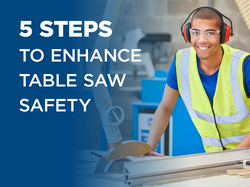- Home
- Loss Control
- Loss Control Insights
- 5 Steps to Enhance Table Saw Safety
Table saws are versatile tools commonly found in various organizations, including schools, cabinet manufacturers and contractors. While many use these tools safely, there are instances where outdated equipment and unsafe practices pose serious risks. Table saw safety is paramount to preventing accidents and injuries. In the following sections, we will delve into the hazards associated with table saws and provide five crucial steps to ensure safety.
The Importance of Table Saw Safety
Table saws operate with blades spinning at 100 miles per hour, making them powerful but potentially dangerous tools. Over 4,000 Americans suffer amputations or hand injuries due to table saw accidents each year. Understanding and implementing proper safety measures is crucial to prevent such incidents.
Main Hazards of Table Saw Use
To emphasize the significance of table saw safety, it's essential to recognize the primary dangers associated with these machines:
Blade Contact
The most severe table saw accidents involve direct contact between the operator's body parts (usually hands) and the rapidly spinning blade. This can result in life-altering injuries.
Kickback
Kickback occurs when the workpiece gets thrown back toward the operator due to incorrect cutting techniques or inadequate safety precautions. It can lead to injuries or damage to the equipment.
Wood Debris and Dust
Table saws generate wood debris and dust, which can obscure the operator's vision and create a hazardous work environment. Inhaling sawdust over time can also have adverse health effects.
Lack of Concentration
A momentary lapse in concentration can have severe consequences when using a table saw. Operators must remain focused on the task, always keeping their hands and the machine guard in the correct positions.
Outdated Equipment
Older table saws with inadequate safety features such as obsolete push sticks pose a significant risk. Investing in newer, safer technology is essential to mitigate these dangers.
5 Steps to Enhance Table Saw Safety
Preventing table saw accidents is a collective effort that involves proper training, equipment maintenance, and adherence to safety procedures. Here are five steps to help you prioritize safety:
- Implement Saw Safety Procedures
Incorporate a comprehensive table saw safety program into your company's safety procedures. Provide thorough training to all employees, regardless of tenure, and use checklists to ensure that safety precautions are followed. Emphasize the importance of techniques like lockout/tagout and machine safeguarding. - Emphasize Focus and Concentration
Stress the importance of concentration and vigilance while operating table saws. Operators must remain fully focused on their work and constantly aware of the location of their hands and the machine guard. Create a distraction-free work environment to minimize the risk of accidents. Keep Updated with the Latest Safety Technology
Stay informed about the latest safety improvements for table saws. Newer devices, such as push blocks and pads, offer better control during cutting, enhancing operator safety. Consider upgrading to table saw models with safety features like saw-stops, which automatically shut down the blade if fingers come too close.Regularly Inspect Saws
Implement regular inspections to identify and address safety issues. While daily checklists can catch common problems, conducting more extensive monthly or quarterly inspections by someone not using the saw daily can reveal broader concerns. Remember to inspect equipment after relocation or movement within the shop as well.Schedule Preventive Maintenance
Include routine maintenance in your table saw safety protocols. Regularly clean equipment and guards, sharpen blades, replace cracked or damaged blades, ensure the table remains level and balanced, and inspect cords and other components for wear and tear.
By following these steps and prioritizing table saw safety, you can reduce the risks associated with these powerful tools, protecting employees and equipment. Safety should always be the top priority when working with table saws.
Get in touch
Need help? We’re here for you! Whether you have questions or need personalized assistance, your local office is ready to support you.
Loss Control Insights
Stay informed with the latest news and receive actionable safety tips, all carefully curated by our team of experts.
